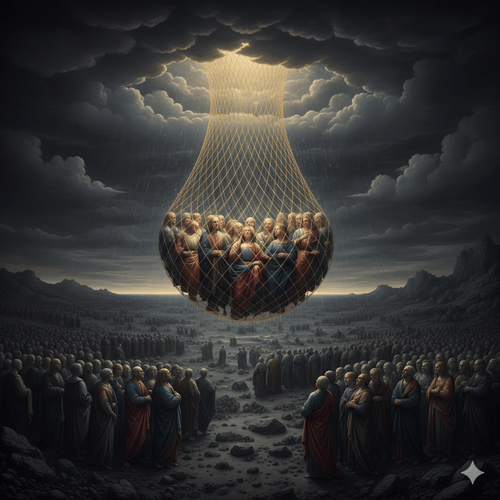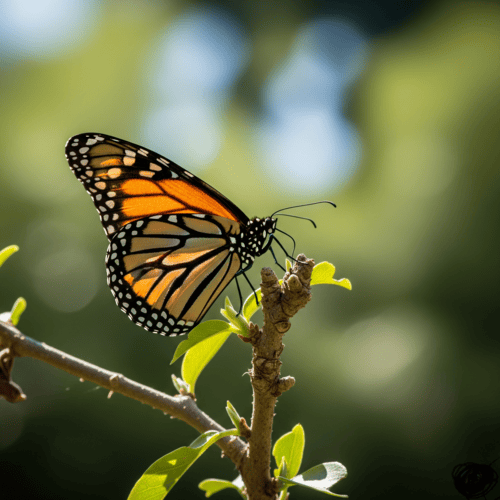Butterflies Don’t Use GPS: The Monarch Migration Miracle
Every fall, something extraordinary happens that should make us pause in wonder. A creature weighing less than a paperclip, with a brain smaller than a pinhead, embarks on a 3,000-mile journey to a destination it has never seen. The fourth-generation monarch butterfly somehow “knows” exactly where to find a handful of oyamel fir forests nestled in the mountains of central Mexico—forests covering less than 50 square miles in all of North America.
How does a butterfly accomplish what would challenge our most sophisticated GPS systems?
NAVIGATION TECHNOLOGY THAT OUTCLASSES HUMAN ENGINEERING
The monarch butterfly operates with not one, but multiple integrated navigation systems that would make aerospace engineers envious:
- Stunningly Precise Solar Compass: These tiny creatures possess a solar compass that calculates direction using the sun’s position combined with an internal molecular clock. They detect Earth’s magnetic field through magnetite crystals embedded in their antennae, creating a biological magnetic compass of stunning precision.
- Polarised Light Detectors: But that’s just the beginning. Monarchs can see polarized light patterns invisible to human eyes, using these celestial highways as guidance even on cloudy days. They recognise landscape features, track wind patterns, and maintain course corrections across an entire continent.
- No-Fail Track Record—At First Attempt: Here’s what makes this truly remarkable: the butterflies making this epic journey have never made it before. The first three generations of monarchs each year live only 2-6 weeks, traveling northward through the United States and southern Canada. But the fourth generation lives eight times longer and somehow “knows” to reverse course, flying thousands of miles south to wintering grounds their great-great-grandparents left months earlier.
There’s no learning period. No practice runs. No GPS recalculations. Perfect execution on the first and only attempt.
MONARCH MIRACLE MIGRATION: PRECISION THAT DEFIES RANDOMNESS
The accuracy of monarch navigation staggers imagination. These butterflies don’t just head vaguely south—they target specific mountain forests at precisely 10,000 feet elevation in central Mexico. They require exact microclimate conditions: temperatures between 32-60°F and specific humidity levels that exist in only a dozen sacred fir groves scattered across the volcanic highlands.
Consider the mathematical impossibility: if a monarch was off by even a few degrees in direction, it would miss its target by hundreds of miles, landing in desert, ocean, or tropical lowlands where it would die. The margin of error approaches zero across a journey spanning multiple time zones, weather systems, and geographic obstacles.
The timing is equally precise. Monarchs launch their migration at the exact moment before killing frosts arrive, coordinate their journey with milkweed plant cycles across the continent, and arrive in Mexico precisely when forest conditions become optimal for overwintering survival. This synchronised continental choreography occurs with clockwork precision year after year.
THE PROGRAMMING EVIDENCE
What we’re witnessing isn’t instinct in any ordinary sense—it’s programming.
Complex, sophisticated programming that stores detailed navigation information in DNA and transmits it flawlessly across generations.
Irreducible complexity presents evolutionists with an insurmountable problem: Remove any single navigation system and the monarch dies. The solar compass without the magnetic backup? Death. The timing mechanism without landmark recognition? Death. These systems must work together from the very first flight, with no room for gradual development.
The energy mystery deepens the design evidence further. Fourth-generation monarchs somehow store enough fuel in their tiny bodies to power non-stop flights exceeding 100 hours across open water and hostile terrain. Their fat reserves must be precisely calculated—too little and they die mid-flight, too much and they’re too heavy to fly efficiently. Even more remarkable, their bodies are programmed to switch metabolic systems during flight, burning stored lipids at exactly the right rate to sustain wing beats for days without rest. It’s like discovering a paper airplane also contains a miniaturised jet engine with perfect fuel injection systems! The biochemical engineering rivals the most sophisticated aircraft fuel management systems.
But the deeper problem is informational. The monarch’s migration route isn’t just a simple direction—it’s a vast database of geographic information, weather patterns, altitude requirements, and seasonal timing. This represents massive amounts of new information encoded in the butterfly’s genetic structure.
Here’s the fatal flaw in evolutionary explanations: genetic mutations consistently destroy or scramble information—they don’t create complex new information systems. Yet monarch navigation requires precisely the kind of integrated information processing that only intelligence can produce.
THE BOOTSTRAP IMPOSSIBILITY
Evolution faces what we might call the “bootstrap problem” with monarch migration. How did the first monarch discover Mexico existed? How did it know flying 3,000 miles south would lead to survival rather than death?
Random mutations can’t explain a butterfly suddenly “deciding” to fly toward a destination it’s never heard of. Natural selection can’t preserve migration abilities before they’re complete and functional. And there’s no evidence in the fossil record of gradual migration development—monarchs appear fully capable of their incredible journey.
The evolutionary story requires us to believe accidental genetic changes somehow encoded a perfect map of North American geography, complete with seasonal timing, altitude requirements, and microclimate specifications. This stretches credibility beyond the breaking point.
MONARCH MIRACLE MIGRATION: THE INESCAPABLE CONCLUSION
When we observe purpose, planning, precision, and integration working together in perfect harmony, we recognise the unmistakable signature of intelligence. This kind of multi-layered complexity—navigation + energy + timing + generational programming working in sync—makes the design inference more compelling and harder to dismiss. Each additional system multiplies the improbability of it all arising by chance.
Surpassing Human Tech: The butterfly’s navigation system outclasses human technology in its integration of multiple guidance systems, its reliability across varying conditions, and its ability to function perfectly without any learning curve. We’d immediately recognise such sophistication as evidence of brilliant engineering if we encountered it in human technology. The Monarch, thus, presents a really robust case that should give any honest reader serious pause about naturalistic explanations for life’s complexity.
MONARCH MIRACLE MIGRATION: RELATED FAQs
How do fourth-generation monarchs “know” to migrate south when their ancestors went north? This is perhaps the most puzzling aspect of monarch migration—what scientists call the “generational paradox.” The first three generations each year live only 2-6 weeks and migrate progressively northward through spring and summer. But the fourth generation lives 6-8 months and possesses completely different programming that compels them to fly south to Mexico. There’s no environmental trigger that could explain this dramatic behavioural reversal, and no learning mechanism to pass the information along. The only reasonable explanation is that this complex programming was embedded in their DNA by an intelligent Designer.
- How do monarchs maintain precise direction during their non-stop, multi-day flights? Monarchs fly continuously for up to 100 hours without rest, maintaining course accuracy that would challenge commercial pilots. They can’t land on water and must navigate around the Gulf of Mexico, requiring split-second directional decisions over vast stretches where a wrong turn means death. During these marathon flights, they must constantly recalibrate their multiple navigation systems while dealing with changing wind patterns, weather fronts, and geographic obstacles. The sustained precision required for multi-day navigation without GPS or external guidance points to sophisticated internal programming that exceeds anything evolution could produce through random mutations.
- What about other animals that migrate long distances—doesn’t this prove evolution can create navigation systems? Many species demonstrate remarkable navigation abilities, including Arctic terns (44,000-mile migrations), sea turtles returning to natal beaches after decades at sea, and salmon finding their birth streams among thousands of waterways. Rather than supporting evolution, these examples multiply the problem exponentially. Each species uses different navigation methods, yet all require the same irreducible complexity and information storage that makes monarch migration impossible to explain naturalistically. The existence of multiple, independently sophisticated navigation systems across unrelated species actually strengthens the case for a common Designer who programmed each creature with the specific abilities needed for survival.
How do monarchs time their departure so perfectly each year? Monarchs begin their southern migration within days of the optimal departure window, somehow “knowing” when food sources will disappear and killing frosts will arrive weeks in advance. They must coordinate this timing across a continent spanning multiple climate zones, departing earlier in northern regions and later in southern areas to arrive simultaneously in Mexico. This requires not just weather prediction capabilities, but continental-scale coordination of millions of individual butterflies. Such precise timing across vast distances and varying conditions suggests a level of programming sophistication that points unmistakably to intelligent design rather than gradual evolutionary development.
- What do creation scientists say about monarch migration? Leading creation scientists like Jonathan Sarfati and Georgia Purdom argue monarch navigation represents a masterpiece of bioengineering that showcases God’s creative genius. They point out the integrated complexity of monarch migration systems exhibits “irreducible complexity”—remove any component and the entire system fails. Creation researchers also emphasise the information required for navigation must come from an intelligent source, as genetic mutations consistently degrade rather than create complex information. Many creation scientists view monarch migration as powerful evidence that biological systems were designed to function perfectly from the beginning, not cobbled together through millions of years of trial-and-error mutations.
- Couldn’t monarchs have learned this route gradually over thousands of years? The learning hypothesis fails on multiple levels because monarch migration requires all-or-nothing success—there are no partial victories. A butterfly that flies halfway to Mexico dies, providing no survival advantage to pass on to offspring. Additionally, the route requires knowledge that individual monarchs could never acquire through experience: the location of specific mountain forests thousands of miles away, optimal altitude requirements, and precise timing across continental weather patterns. Most critically, the fourth generation making the journey has never been south before and will die in Mexico, making it impossible to pass learned information to the next generation. Only pre-programmed genetic information can account for this phenomenon.
Why don’t we see monarch migration evolving or improving over time? If migration abilities evolved gradually, we should observe monarchs developing better navigation, discovering new routes, or adapting to climate changes in real-time. Instead, monarch migration appears to be a fixed, perfectly calibrated system that has remained essentially unchanged throughout recorded observation. When environmental factors disrupt their programmed routes (such as habitat loss), monarchs struggle rather than innovate new solutions. This suggests their migration is the result of front-loaded design rather than ongoing evolutionary adaptation. The absence of observable improvement or innovation in monarch navigation supports the view that these abilities were created complete and functional from the beginning, rather than developed through evolutionary processes.
MONARCH MIRACLE MIGRATION: OUR RELATED POSTS
- The Emperor Penguin: Designed to Thrive in Extreme Climates
- The Pelican: Precision-Engineered Fishing Vessel
- Explosive Evidence: How the Bombardier Beetle Demolishes Darwinism
- Nature’s Puzzle: The Platypus as Evidence of Divine Engineering
- Bats: How Nature’s Flying Marvels Defy Evolution
- Tadpole to Frog: How Metamorphosis Reveals Divine Programming
- Honeybees: 5 Ways Nature’s Unsung Architects Point to the Creator
- Testament to Design: The Engineering Marvel of Elephants
- Blue Whales: Mammoth Icons of Intelligent Design
- The Woodpecker’s Design: How Nature’s Headbanger Defies Evolution
- Too Perfect to Be Random: The Giraffe’s Remarkable Design
Editor's Pick

Why Do People Hate the Doctrine of Election?
…WHEN THEY REALLY SHOULDN’T Few Bible doctrines provoke stronger reactions than election. The idea that God chose some for salvation [...]

The Doctrine of Providence: Does God Really Govern All Things?
You’re sitting in the doctor’s office when the diagnosis lands like a thunderclap. Your mind races: Why this? Why now? [...]

No Decay, No Defeat: What It Means That Christ’s Body Saw No Corruption
On the Day of Pentecost, Peter stood before thousands and made a startling claim: David's body decayed in the tomb, [...]
SUPPORT US:
Feel the Holy Spirit's gentle nudge to partner with us?
Donate Online:
Account Name: TRUTHS TO DIE FOR FOUNDATION
Account Number: 10243565459
Bank IFSC: IDFB0043391
Bank Name: IDFC FIRST BANK






